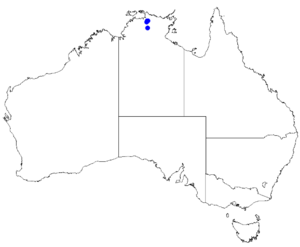Boronia suberosa facts for kids
Quick facts for kids Boronia suberosa |
|
|---|---|
| Scientific classification | |
 |
|
| Occurrence data from Australasian Virtual Herbarium |
Boronia suberosa is a special plant found only in a small part of the Northern Territory, Australia. It belongs to the citrus family, called Rutaceae, just like oranges and lemons! This plant is a small shrub with branches that hang down. It has simple leaves and pretty white flowers with four tiny petals.
Contents
What Does Boronia suberosa Look Like?
Boronia suberosa is a shrub that can grow up to 50 centimeters (about 20 inches) tall. Its branches droop, giving it a graceful look. When the branches are young, they have tiny star-shaped hairs. As they get older, they become very corky, almost like bark.
The leaves of this plant are simple, meaning they are not divided into smaller leaflets. They are shaped like an oval or a spear. They are usually 7 to 20 millimeters (about 0.3 to 0.8 inches) long and 3 to 11 millimeters (about 0.1 to 0.4 inches) wide. Each leaf sits on a small stem called a petiole, which is up to 3 millimeters long.
The flowers grow one by one. They have green, egg-shaped parts called sepals, which are 3 to 5 millimeters long. These sepals are actually bigger than the white petals, which are about 2.5 to 3 millimeters long. Both the sepals and petals grow larger as the fruit starts to form.
You can usually see Boronia suberosa flowering between February and May. After the flowers, the plant produces a fruit. This fruit is a small, somewhat hairy capsule. It is about 3.5 to 5 millimeters long and 2 to 2.5 millimeters wide.
How Was Boronia suberosa Named?
Scientists give every living thing a unique name. This helps them study and talk about plants and animals. The plant Boronia suberosa was first officially described in 1997. It was named by a scientist named Marco F. Duretto. He published his description in a science journal called Austrobaileya.
The second part of its name, suberosa, is a Latin word. It means "corky". This name was chosen because the plant's older branches become very corky.
Where Does Boronia suberosa Live?
This special boronia plant grows on sandstone rocks and cliff faces. It is only found in one specific area. This area is called the Ja Ja formation, located inside Kakadu National Park.
Is Boronia suberosa in Danger?
This plant is currently listed as "near threatened". This means it is not in immediate danger of disappearing. However, it could become threatened in the future if its habitat changes. This listing is under the Territory Parks and Wildlife Conservation Act 2000. This law helps protect plants and animals in the Northern Territory.

